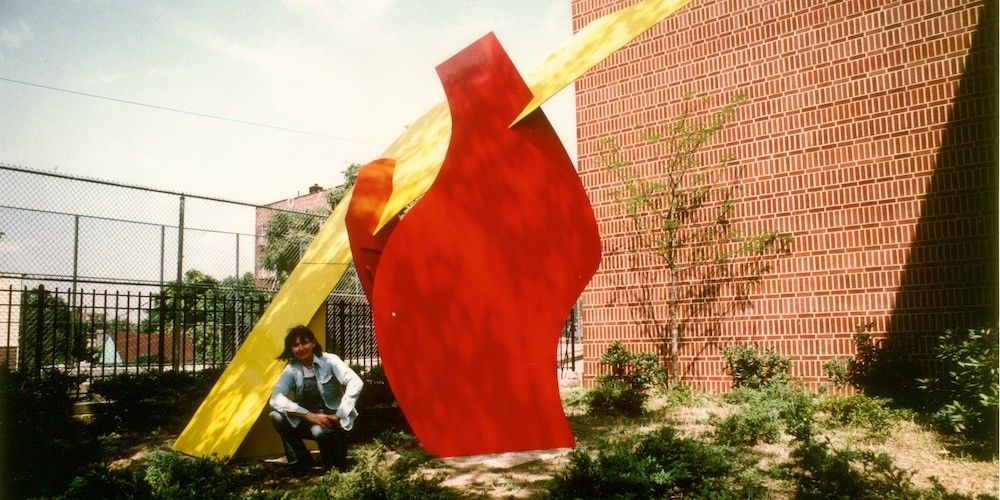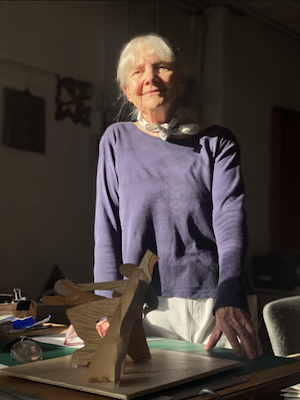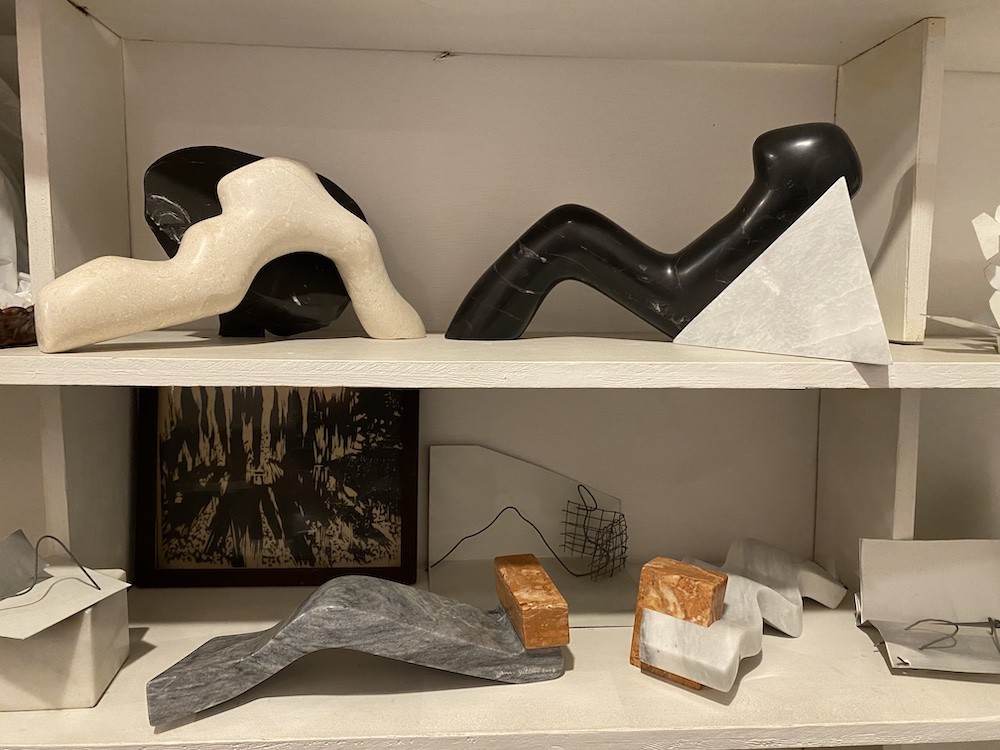At 88, Alumna Ann Gillen’s Favorite Artwork is Still in The Works
Upon entering the studio of Visual Arts alumna Ann Gillen ’69, one is immediately amazed by the aura of creative energy suffusing the space. As I stepped into the old artist studio in SoHo, feeling the slight give of the wood beneath my feet, the first thing that struck me was the sheer number of sculptures. Her life's work, illuminated by natural light filtering through the high windows, occupied most of the room, except for a modest bed in a corner and a pair of teacups in the sink.
Gillen, welcoming me with a bright and friendly smile, took my hand and quickly led me to one sculpture crafted from marine plywood during her MFA at Columbia University School of the Arts. “I was celebrating the right to protest. If young people don’t fight for the world, we are lost. Students have to remember the First Amendment,” she said.
At eighty-eight years old, Gillen still has a youthful outlook on life, full of fresh hope and never-ending creativity. Earlier this year, Gillen was featured in The New York Times, where her work was described as the ideal of art as a public good. She recently unveiled Toward Civic Art, a sculpture exhibition at Polina Berlin Gallery that ran through January 14, 2023, and marked Gillen’s first solo gallery exhibition in twenty years. Concerned with structure, construction, and scalability, her sculpture practice has taken shape on both monumental and intimate scales, with works realized in various materials.
For the next two hours, I would spend most of the interview either laughing or awe-struck, since Gillen balanced seriousness and jokes with a striking tempo. “The New York Times made me famous in a way,” she said, with the characteristic laughter that would never abandon her during the whole conversation. “How does it feel?” I asked her. “Well, I know it is fleeting!” she said.
Gillen grew up in Brooklyn. Her parents, an art teacher and a lawyer, taught her the importance of art, making it an obvious path for Gillen from a very young age. Her epiphany as an artist came when she was 11 years old: she went to see how they built the United Nations headquarters in Manhattan and was obsessed with the architecture and materials they used.
Gillen trained in Industrial Design at Pratt Institute and later earned an MFA from Columbia in 1969. “Pratt gave me the Bauhaus exercises of structure and materials. Columbia gave me the formal understanding of my life's work in which I was already engaged,” she said. “Thanks to my Bauhaus background, I learned a lot of other things which sculptors wouldn't learn. The relationship between form, structure and material, and how shapes could vibrate, communicating the city’s feelings.”
Since then, Gillen has created some of New York's most influential public art, encompassing sculpture, drawing, design, print-making, and book-making. She has constructed 30 public, private, and corporate commissions in various materials, from sculptures for Bellevue and Lincoln hospitals, a permanent installation at CUNY’s Graduate School of Journalism, or a frieze for the Queens Public Library’s Marathon Parkway branch.
Her first solo exhibition was in 1961 at the Weyhe Gallery in New York City, two years after graduating from Pratt, where she showed colored, woodcut, hand-printed books. Her later sculptures reflect an obsession with geometry and movement, drawing lines within a geometric frame, inspired by the aesthetic uses of the Greek theory of matter, which considers geometric forms to explain spatial relationships.
“My work is based on construction, gravity and speed. What does 'resistance to gravity' mean? How do you hold something up? How do you resist the pull of the earth? These are the questions that obsess me,” she said. “Gravity is pretty basic: if you don’t think about it, the sculpture falls down."
Outside Gillen’s studio, the sounds of honking horns, revving engines, and the chatter of pedestrians filled the air. The streets were throbbing with life almost as much as Gillen herself, who regaled me with stories about New York. As the NYT piece pointed out, she’s a natural product of the city. She exhibited in Vassar College, 1976; Wave Hill, 1977; Bellevue Hospital Park,1983-84; and CUNY Tech Brooklyn, 1984. Her work has been exhibited outdoors in places like Storm King, Central Park, Pratt Sculpture Park and Max Hutchinson’s Sculpture Fields, among others.
Gillen has had a symbiotic relationship with New York: the city benefitted from her notion of public art, and she was also deeply influenced by its architecture and verticality. An important part of her creative process was riding a bicycle through the city—an experience she described as both exhilarating and sometimes challenging—looking at the skyscrapers around her, their glass and steel facades reflecting the sunlight in dazzling flashes. “I was on my bicycle on Park Avenue and 50th Street one day. I stopped at a traffic light, looked right and…you know who was next to me, riding another bicycle too?"
“Who?”
"Katherine Hepburn!”
Another essential part of Gillen’s career is her feminist activism. When she was a student at Pratt, she was one of the only female students in the room. In the 70's and 80's she was a board member of two women artist's organizations—Women in the Arts and The Women’s Interart Center—and co-founder of NY Professional Women Artists. The three of them provided venues, workshops and training courses to female artists to encourage the development and expression of women's skills. In 1974, she gave a lecture at the New School called “What If the World’s Art and Architecture Had Been Shaped by Women?”
Almost 50 years later, I asked her the same question. She wasn’t caught off-guard. She sipped her glass of water, smiled and said: “It is always tough to imagine life differently since we have been trained to look at it from only one perspective. If architecture had been shaped by women…would all the buildings have been round?” she laughed. “Who said that every building has to be cubic? Maybe we could have more round buildings.”
She took me to the rear side of her studio. Hundreds of small sculptures, pocket-sized maquettes, and figures made out of wood and stone represented almost seven decades of art. At some point, looking at a small figure made out of marble, I asked if, after all these years, she had figured out the million-dollar question: Who is the viewer? Who are you making art for? She looked at me and said point-blank: “I’m just solving the problem I set up for myself. If you start thinking about that, you get crazy. You think: 'This person doesn’t like the color purple. I can’t do this.' Then you go mad!”
Gillen clearly has fun at work. She is vivacious and eloquent, even when she fails. “It's fun to take serious stainless steel and serious blue marble and make a joke,” she told me, showing me a reproduction of a piece of her work. When I asked her what her relationship with failure was, she made a gesture with her hand, as if she were trying to scare failure away. “Failure has been a constant in my life…except when it wasn’t!” she said, bursting into laughter. “You can’t think about failure. You can’t carry it around. That’s what is so great about New York. Nobody has to know… nobody cares!”
What's your favorite piece? I asked. In a room filled with hundreds of small sculptures made of wood, metal, and marble, I assumed she would have a clear favorite—and she did. But it was not what I expected. “My favorite is the one I’m working on right now,” she said, this time as serious as ever. I looked at her, my mouth half-open. Despite a lifetime of creating art, she approaches each new project with renewed wonder and excitement. Then she added something that should be carved in stone—or any other material she likes: “That’s how you keep going as an artist. That’s how you keep going in life.”
Ann Gillen's studio
Ann Gillen '69, LinebyLine, (Triptych Relief, 25 x 30 x 1.5', stainless steel tube and rod, red walls, 2007) CUNY Graduate School of Journalism Commission, courtesy of Ann Gillen/Artists Rights Society (ARS)NY
Ann Gillen, To The Theater, (Lincoln Center Commission, 1994-96) Courtesy the artist and Artists Rights Society (ARS) NY.
Ann Gillen, To The Theater, (Lincoln Center Commission, 1994-96) Courtesy the artist and Artists Rights Society (ARS) NY.


